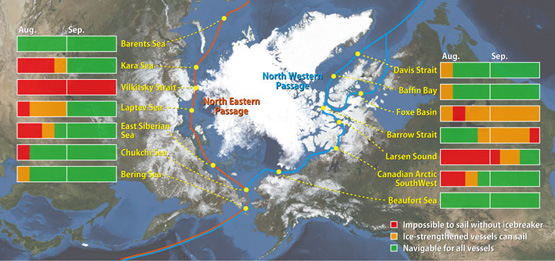2008.09.30
-The Latest news from WNI Global Ice Center-
The sea ice extent for the Arctic region reached the 3rd lowest,
but both Eastern and Western routes were not completely open
The Global Ice Center at Weathernews, Inc. has announced that both the North Western (via Canada) and the North Eastern (via Russia) routes have not opened this summer. According to the Global Ice Center’s analysis, in 2009 the sea ice extent reached a minimum in early September. This was recorded to be the third lowest extent since 1978. The lowest sea ice extent was recorded in 2007, these extreme minimums witnessed in recent years have been suggested to be a result of the global warming effect. Sea ice extent in the Northern hemisphere has now started to increase meaning that there is no expectation that the Arctic routes will open in 2009. Although at present (29th September) the North Eastern route remains predominantly open for navigation purposes.
[Synoptic features of this year]
Temperatures within the Arctic region this summer were generally higher, and sea ice extent was lower than the thirty-year average. Within the North Eastern route temperatures were generally below recent years, and within the North Western route temperatures were above recent years average. This trend in temperature patterns has shown agreement with a statistical trend describing temperatures in the Arctic during an El Niño year. However, pressure patterns this summer were not like the pattern seen in 2007 in which winds effectively supported the migration of sea ice towards the North Atlantic. This is the one of the possible reason that the routes were not open this summer.
[Ice condition of the Arctic routes this year]
North Eastern route (via Russia)
By the start of August the majority of sea ice had already melted within the North Eastern route, suggesting the possibility of the opening of the route, as the sea ice extent was lower in August 2009 than it had been in the same month of 2008.
Through out August, sea ice melted quickly leaving just an area within the Vilkitsky strait stopping the opening of the route. However, pressure patterns later caused the migration of sea ice towards this area stopping the region from becoming ice free, this was exacerbated by the introduction of cold water from further north and as a result sea ice remained in this area. Although the routes never completely opened, the North Eastern route did support two German commercial vessels, which was assisted by the use of Russian icebreaker, these may have been needed at the Vilkitsky strait to break through a band of sea ice, which was tens of kilometres in width.
North Western route (via Canada)
Within the Canadian Arctic region, thick fast ice started to decrease later than previous years, this cleared by the start of September, although still leaving the route blocked with sea ice. Towards the end of September, sea ice of Larsea Sound had decreased, introducing an opening of the route at this region. However at the same time, sea ice had started accumulating within the Barrow Strait and as a result the North Western passage did not completely open.
[I-SEE-ENGINE --Global Ice Center's prediction tool]
The Global Ice Center at Weathrenews, Inc. predicts sea ice extent with the use of their original prediction model named the I-SEE-ENGINE. It is known that surface winds, and currents affect sea ice migration, through the use of this model the Global Ice Center is able to examine ice movement and determine possible future routes.
The Global Ice Center at Weathrenews, Inc. monitor sea ice conditions and route situation and published their results via the website (http://weathernews.com/GIC/). Although the Global Ice Centre has now finished monitoring sea ice melting within the Arctic region for the summer of 2009, it is still committed to monitoring sea ice around the world. At present the Global Ice Center is currently monitoring the Okhotsk Sea, which is now the focus for the Sakhalin 2 liquid natural gas project.
Weathernews Inc. is the world's largest private weather service company headquartered in Japan. It is the only global weather content maker that employs over 600 staff (including more than 200 meteorologists) in offices in 32 cities in 16 countries and regions Media Contact: Ryoji Morishita / Yuka Youda TEL: +81 43 274 5504 / E-Mail: sr-corner@wni.com


